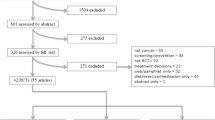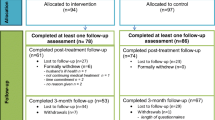Abstract
Goals of work
Based on meta-analyses regarding the preparation of patients for potentially threatening medical procedures, a DVD, incorporating behavioral role modelling, was developed to prepare patients for chemotherapy and assist them to self-manage side effects. It was hypothesized that patients who watched the DVD (vs those who did not) would report (1) lower anxiety; (2) higher self-efficacy related to coping with treatment side effects; (3) fewer supportive care needs; and (4) higher satisfaction with information received. It was further hypothesized that these effects would be stronger in those perceiving their treatment intent to be curative rather than palliative.
Materials and methods
Quasi-experimental design using a historical control group was employed. Participants were scheduled to receive their first ever chemotherapy treatment. Group 1 (usual care; n = 50) was prospectively recruited before the release of the DVD and group 2 (DVD plus usual care; n = 50) after the release. Before commencing chemotherapy, all patients completed reliable and valid measures of self-efficacy, anxiety, and supportive care needs. Data was stratified according to perceived treatment intent. Independent sample t tests were performed for each group (curative vs palliative).
Main results
Significant differences were found between the usual care and intervention groups: for self-perceived curative patients in relation to self-efficacy for seeking social support (p = 0.044), with increased confidence in those watching the DVD, and for self-perceived palliative patients in relation to their satisfaction with information about side effects (p = 0.026), with increased satisfaction in those watching the DVD. Overall, significant differences were found between self-perceived curative vs palliative patients on measures of self-efficacy and supportive care needs, with self-perceived curative patients reporting more confidence and fewer needs.
Conclusions
The educational DVD was considered highly acceptable by patients and was found to increase self-efficacy and reduce supportive care needs. Hence, it is appropriate to give to patients before face-to-face chemotherapy education. Additional pretreatment education is recommended, particularly for self-perceived palliative patients, to reduce their pretreatment anxiety and enhance their confidence in coping with treatment.




Similar content being viewed by others
References
Avis M, Bond M, Arthur A (1995) Satisfying solutions? A review of some unresolved issues in the measurement of patient satisfaction. J Adv Nurs 22:316–322
Bonevski B, Sanson-Fisher R, Girgis A, Burton L, Cook P, Boyes A (2000) Evaluation of an instrument to assess the needs of patients with cancer. Supportive Care Review Group. Cancer 88:217–225
Carelle N, Piotto E, Bellanger A, Germanaud J, Thuillier A, Khayat D (2002) Changing patient perceptions of the side effects of cancer chemotherapy. Cancer 95(1):155–163
Carey M, Jefford M, Schofield P, Kelly S, Krishnasamy M, Aranda S (2006) Development and evaluation of an audiovisual information resource to promote self-management of chemotherapy side-effects. Support Care Cancer 14:361–368
Carey M, Schofield P, Jefford M, Krishnasamy M, Aranda S (2007) The development of audio-visual materials to prepare patients for medical procedures: an oncology application. Eur J Cancer Care (in press)
Carpenter DJ, Gatchel RJ, Hasegawa T (1994) Effectiveness of a videotaped behavioral intervention for dental anxiety: the role of gender and the need for information. Behav Med 20:123–132
Coates A, Abraham S, Kaye SB, Sowerbutts T, Frewin C et al (1983) On the receiving end-patient perception of the side-effects of cancer chemotherapy. Eur J Cancer Clin Oncol 203–208
Dodd MJ (1984) Self-care for patients with breast cancer to prevent side effects of chemotherapy: a concern for public health nursing. Public Health Nurs 1:202–209
Dodd MJ (1988) Efficacy of proactive information on self-care in chemotherapy patients. Patient Educ Couns 11:215–225
Done ML, Lee A (1998) The use of a video to convey preanesthetic information to patients undergoing ambulatory surgery. Anesth Analg 87:531–536
Dunn J, Steginga SK, Rose P, Scott J, Allison R (2004) Evaluating patient education materials about radiation therapy. Patient Educ Couns 52:325–332
Durst LM (1990) Preoperative teaching videotape. The effect on children’s behavior. AORN J 52:576–584
Griffin AM, Butow PN, Coates AS, Childs AM, Ellis PM et al (1996) On the receiving end. V: patient perceptions of the side effects of cancer chemotherapy in 1993. Ann Oncol 7:189–195
Hanson Frost M, Suman VJ, Rummans TA, Dose AM, Taylor M et al (2000) Physical, psychological and social well-being of women with breast cancer: the influence of disease phase. Psychooncology 9:221–231
Harrison R, Dey P, Slevin NJ, Eardley A, Gibbs A et al (2001) Randomized controlled trial to assess the effectiveness of a videotape about radiotherapy. Br J Cancer 84:8–10
Hathaway D (1986) Effect of preoperative instruction on postoperative outcomes: a meta-analysis. Nurs Res 35:269–275
Jefford M, Tattersall MH (2002) Informing and involving cancer patients in their own care. Lancet Oncol 3:629–637
Kissane D, Yates P (eds) (2003) Psychological and existential distress. Amused Publications, Australia, pp 229–244
Krouse HJ (2001) Video modelling to educate patients. J Adv Nurs 33:748–757
Lin PC, Lin LC, Lin JJ (1997) Comparing the effectiveness of different educational programs for patients with total knee arthroplasty. Orthop Nurs 16:43–49
Luck A, Pearson S, Maddern G, Hewett P (1999) Effects of video information on precolonoscopy anxiety and knowledge: a randomised trial. Lancet 354:2032–2035
McDaniel RW, Rhodes VA (1998) Development of a preparatory sensory information videotape for women receiving chemotherapy for breast cancer. Cancer Nurs 21:143–148
Merluzzi TV, Nairn RC, Hegde K, Martinez Sanchez MA, Dunn L (2001) Self-efficacy for coping with cancer: revision of the cancer behavior inventory (version 2.0). Psychooncology 10:206–217
Moorey S, Greer S, Watson M, Gorman C, Rowden L et al (1991) The factor structure and factor stability of the hospital anxiety and depression scale in patients with cancer. Br J Psychiatry 158:255–259
Mynaugh PA (1991) A randomized study of two methods of teaching perineal massage: effects on practice rates, episiotomy rates, and lacerations. Birth 18:153–159
O’Connor AM, Rostom A, Fiset V, Tetroe J, Entwistle V et al (1999) Decision aids for patients facing health treatment or screening decisions: systematic review. BMJ 319:731–734
Rainbird KJ, Perkins JJ, Sanson-Fisher RW (2005) The needs assessment for advanced cancer patients (NA-ACP): a measure of the perceived needs of patients with advanced, incurable cancer. a study of validity, reliability and acceptability. Psychooncology 14:297–306
Robertson C, Gatchel RJ, Fowler C (1991) Effectiveness of a videotaped behavioral intervention in reducing anxiety in emergency oral surgery patients. Behav Med 17:77–85
Sanson-Fisher R, Girgis A, Boyes A, Bonevski B, Burton L, Cook P (2000) The unmet supportive care needs of patients with cancer. Supportive Care Review Group. Cancer 88:226–237
Suls J, Wan CK (1989) Effects of sensory and procedural information on coping with stressful medical procedures and pain: a meta-analysis. J Consult Clin Psychol 57:372–379
Thomas R, Daly M, Perryman B, Stockton D (2000) Forewarned is forearmed—benefits of preparatory information on video cassette for patients receiving chemotherapy or radiotherapy—a randomised controlled trial. Eur J Cancer 36:1536–1543
Velikova G, Booth L, Smith AB, Brown PM, Lynch P et al (2004) Measuring quality of life in routine oncology practice improves communication and patient well-being: a randomized controlled trial. J Clin Oncol 22:714–724
Zigmond AS, Snaith RP (1983) The hospital anxiety and depression scale. Acta Psychiatr Scand 67:361–370
Acknowledgements
The DVD development was supported by a grant from the Peter MacCallum Cancer Foundation. Dr. Penelope Schofield is the Pratt Foundation Senior Research Fellow. We also wish to thank volunteers from the Cancer Connect program and The Cancer Council Victoria for assisting with this project. The research staff who undertook this study were partially supported by grants from the Leukaemia Foundation Australia and a project grant from the National Health and Medical Research Council for conduct of the randomized controlled trial.
Author information
Authors and Affiliations
Corresponding author
Rights and permissions
About this article
Cite this article
Schofield, P., Jefford, M., Carey, M. et al. Preparing patients for threatening medical treatments: effects of a chemotherapy educational DVD on anxiety, unmet needs, and self-efficacy. Support Care Cancer 16, 37–45 (2008). https://doi.org/10.1007/s00520-007-0273-4
Received:
Accepted:
Published:
Issue Date:
DOI: https://doi.org/10.1007/s00520-007-0273-4




